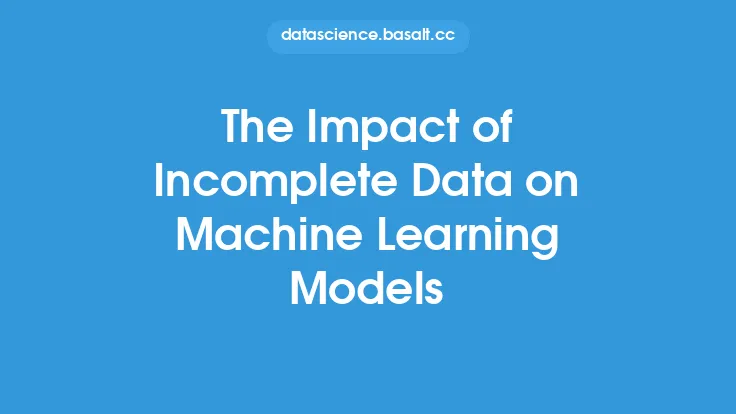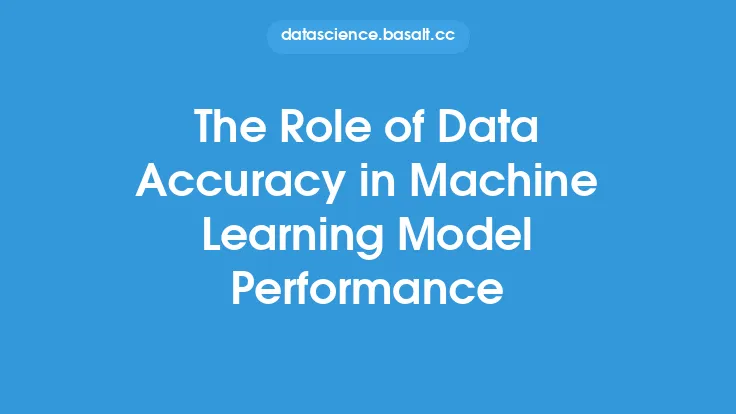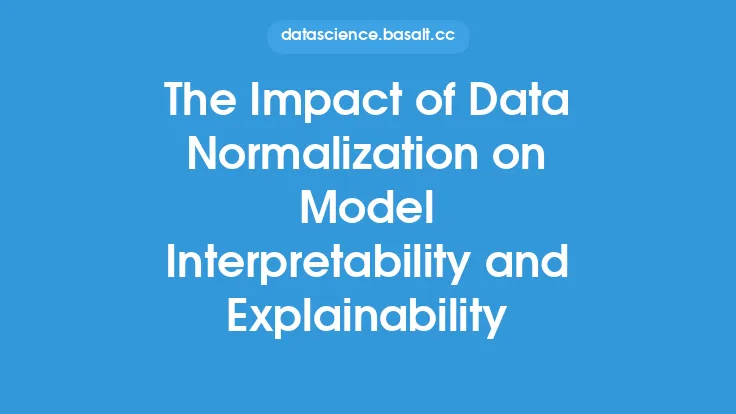Data preparation is a crucial step in the machine learning workflow, as it directly affects the performance of the model. The quality of the data used to train a machine learning model has a significant impact on its ability to make accurate predictions or take appropriate actions. In this article, we will explore the impact of data preparation on machine learning model performance and discuss the key considerations that data scientists and analysts should keep in mind when preparing their data.
Introduction to Data Preparation
Data preparation involves a series of steps that are taken to ensure that the data is in a suitable format for use in machine learning modeling. This includes data cleaning, feature engineering, data transformation, and data reduction. The goal of data preparation is to create a dataset that is accurate, complete, and consistent, and that can be used to train a machine learning model that generalizes well to new, unseen data. Data preparation is a time-consuming and labor-intensive process, but it is essential for building high-quality machine learning models.
The Impact of Data Quality on Model Performance
The quality of the data used to train a machine learning model has a direct impact on its performance. Poor-quality data can lead to poor model performance, while high-quality data can result in a model that is accurate and reliable. There are several ways in which data quality can affect model performance, including:
- Noise and outliers: Noisy or outlier data points can affect the model's ability to generalize to new data. These data points can be removed or transformed to reduce their impact on the model.
- Missing values: Missing values can affect the model's ability to make accurate predictions. There are several strategies for handling missing values, including imputation, interpolation, and deletion.
- Inconsistent data: Inconsistent data can affect the model's ability to make accurate predictions. This can include data that is not in a consistent format, or data that contains errors or inconsistencies.
- Irrelevant features: Irrelevant features can affect the model's ability to make accurate predictions. These features can be removed or transformed to reduce their impact on the model.
Data Preparation Techniques for Machine Learning
There are several data preparation techniques that can be used to improve the quality of the data and the performance of the machine learning model. These include:
- Data normalization: Data normalization involves scaling the data to a common range, usually between 0 and 1. This can help to prevent features with large ranges from dominating the model.
- Feature engineering: Feature engineering involves creating new features from existing ones. This can help to improve the model's ability to make accurate predictions.
- Data transformation: Data transformation involves transforming the data into a more suitable format for modeling. This can include transforming categorical variables into numerical variables, or transforming non-normal data into normal data.
- Dimensionality reduction: Dimensionality reduction involves reducing the number of features in the dataset. This can help to improve the model's ability to make accurate predictions and reduce the risk of overfitting.
The Importance of Data Exploration
Data exploration is an essential step in the data preparation process. It involves examining the data to understand its distribution, relationships, and patterns. This can help to identify issues with the data, such as missing values, outliers, and inconsistent data. Data exploration can also help to identify opportunities for feature engineering and data transformation.
The Role of Data Visualization in Data Preparation
Data visualization is a powerful tool for data preparation. It involves using plots and charts to visualize the data and understand its distribution, relationships, and patterns. Data visualization can help to identify issues with the data, such as missing values, outliers, and inconsistent data. It can also help to identify opportunities for feature engineering and data transformation.
Best Practices for Data Preparation
There are several best practices that can be followed to ensure that the data preparation process is effective and efficient. These include:
- Start with a clear understanding of the problem: It is essential to have a clear understanding of the problem that the machine learning model is intended to solve. This can help to guide the data preparation process and ensure that the data is prepared in a way that is relevant to the problem.
- Use a systematic approach: A systematic approach to data preparation can help to ensure that all necessary steps are taken and that the data is prepared consistently.
- Document the process: Documenting the data preparation process can help to ensure that the process is reproducible and that the data is prepared in a way that is consistent with the problem.
- Continuously evaluate and refine the process: The data preparation process should be continuously evaluated and refined to ensure that it is effective and efficient.
Conclusion
Data preparation is a critical step in the machine learning workflow, as it directly affects the performance of the model. The quality of the data used to train a machine learning model has a significant impact on its ability to make accurate predictions or take appropriate actions. By following best practices for data preparation, such as starting with a clear understanding of the problem, using a systematic approach, documenting the process, and continuously evaluating and refining the process, data scientists and analysts can ensure that their data is prepared in a way that is relevant to the problem and that supports the development of high-quality machine learning models.





